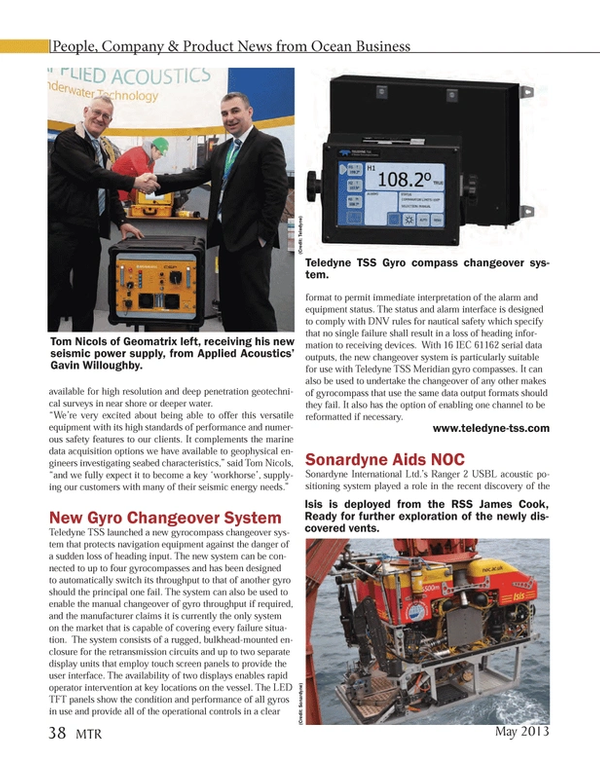
Sonardyne Aids NOC
Sonardyne International Ltd.’s Ranger 2 USBL acoustic positioning system played a role in the recent discovery of the world’s deepest known undersea volcanic vents by a team from the National Oceanography Center (NOC) in Southampton. The expedition used Ranger 2 to track the Remotely Operated Vehicle (ROV) Isis from the RRS James Cook, 5,000 meters beneath the surface as it recorded video and imagery whilst collecting samples from the newly discovered vents in the Cayman Trough. The expedition, funded by the Natural Environmental Research Council (NERC), saw the researchers, from NOC and the University of Southampton, return to a set of vents – in the Beebe Hydrothermal Vent Field – that they discovered during an expedition in 2010. At the time, these were believed to be the world’s deepest.
Geraint West, Head of NOC’s National Marine Facilities, Sea Systems, which provides ships and submersibles to the U.K. marine science community on behalf of NERC, explained, “The science team and ROV crew came across a further set of vents located even deeper at 4,968 meters, or almost three miles beneath the ocean surface. NOC has used Sonardyne’s positioning systems since the Isis ROV was first commissioned in 2003 and the Ranger 2 system is central to Isis’ precise positioning system. This enabled the ROV to explore this latest discovery; using various sensors and samples, they were able to determine that these vents are among the hottest on the planet, blasting out water at around 401°C.”
www.sonardyne.com
(As published in the May 2013 edition of Marine Technologies - www.seadiscovery.com)
Read Sonardyne Aids NOC in Pdf, Flash or Html5 edition of May 2013 Marine Technology
Other stories from May 2013 issue
Content
- What Goes Down ... page: 14
- MHI to Build for PGS page: 18
- Exploring the Abyss page: 20
- Unmanned Surface Vessels page: 24
- Unmanned Surface Vessels: Wave Glider SV3 page: 32
- Unmanned Surface Vessels: C-Stat Mobile Buoy USV System page: 34
- Ocean Business Sold page: 36
- Partrac, Rockland Scientific Announce Partnership page: 36
- Ashtead Increases Sonardyne 6G Rental Pool page: 36
- Seatronics Invests in Teledyne TSS Products page: 37
- Geomatrix Buys Applied Acoustics’ Energy Source page: 37
- New Gyro Changeover System page: 38
- Sonardyne Aids NOC page: 38
- EvoLogics Showcase Latest Developments page: 39
- Forum Subsea Rentals Adds iXBlue Systems page: 40
- DP-PHINS Adds to Acoustics page: 40
- Kongsberg to Offer AUV Rentals page: 41
- Fugro Upgrades DeepWorks page: 41
- Teledyne Moves Portfolio to Odom page: 42
- Ashtead Technology Launches Electric Dredge page: 42
- Navigation, Tide and Weather Information via Twitter page: 43


